History

About Pathways Baptist Church
Pathways Baptist Church was formed in 2016 as a result of a merger of two
long-standing, well-established congregations. Our church is a unique multi-cultural,
multi-national, multi-lingual congregation in Gaithersburg, Maryland. At last count,
we had at least 25 nationalities represented within our congregation. The diversity
of the congregation’s membership extends to include ethnic, socioeconomic,
denominational backgrounds, and educational diversity. The geographical proximity
to the nation's capital adds additional depth to this diversity and offers us the opportunity
to reach the nations of the world in our backyard.
Our vision: “Walking together with Jesus to change lives”
Our mission: “Following Jesus, Loving People, Bringing Hope”
Governance
We are congregationally governed and practice policy governance. Elders provide spiritual
oversight and direction for the church, while the Deacons are servant-leaders in a variety of
ministries, including congregational care. Pathways strongly affirms Galatians 3:28, and
welcomes men and women into any and all areas of ministry for which they are gifted and
called. Our current ministerial staff include a Senior Pastor, Discipleship Pastor, Student
Ministries Pastor, Minister of Multicultural Worship, and a Children's Minister.
Our Connections
Pathways is affiliated with the D.C. Baptist Convention and cooperates with American
Baptists, the Cooperative Baptist Fellowship, , and other networks in order to fulfill our
mission at home and abroad. Pathways shares its facility with a Brazilian Baptist church,
and a Latino church which create many opportunities for cross-cultural worship and service.
Our Beliefs
Pathways has chosen to identify its beliefs according to seven “banners” we
wave as the core foundations of our belief:
Jesus centered
Biblically faithful
Spirit led
Disciple forming
Externally focused
Congregationally governed
Baptist affiliated
NEVER UNDERESTIMATE THE POWER OF AN IDEA and A DREAM...
Two neighbors talked over the fence one day in 1955. Inez Perry offered Mary Harris an onion for a recipe in order to save her a trip to the grocery. As they visited, both discovered their common faith in Jesus Christ as Baptist believers and lamented the fact that there was not a Baptist church in the small town of Gaithersburg. That day an idea and a dream was launched in their conversation. They decided to pray and seek others who would help to establish a local Baptist church in town. The dream led them to invite two local DC Baptist pastors to meet with them at Mary Harris' house at 114 Hutton Street on April 13, 1955 and to discern how to go about starting a new church. Out of that meeting they were determined to spread the vision of a Baptist church in Gaithersburg. They published the meeting over the radio and distrubuted invitation to neighbors and residents of a meeting on April 26 to pray and to discuss organizing a church.
The group in only its second meeting determined that the Spirit of God was leading them to step out in faith and establish a Baptist congregation that would be up and running as quickly as possible. As a result of the second meeting, plans were embraced to start worship services, develop a Sunday School, and locate a meeting place as well as get letters to all prospective members and to contact an interim pastor. They began to call themselves the First Baptist Church of Gaithersburg.
On May 15,1955, the young church held its first meeting at the local movie theater with Rev. Robert N. Smith, Associate Pastor of Wisconsin Avenue Baptist Church (a DC Baptist Convention church who helped sponsor the new work) preaching the first service. Thirty persons were present. Rev. Smith served as beginning interim pastor for the new church.
Following this service, a resolution was accepted for forming the church. This meeting was held at the old Gaither Movie Theatre. In June of 1955 the local Masonic Hall became the regular meeting place for the church while looking for a site to purchase. Their spirit and numbers grew. Rev. Robert N. Smith became the officiating minister while the church established its identity in the community.

The white house, October, 1955. The memorial walkway marks this spot on today's campus.
In October 1955, the congregation took a bold faith step by purchasing 8.3 acres of land with a white house on the property. Mr. Bill Norman, a charter member and committed lay leader, guided the church to purchase the property we still inhabit. His visionary leadership made it possible for the church in later years to have room to expand. By purchasing a larger amount of land than necessary for the small congregation, there was from the beginning the vision of expanded ministry. Bill Norman's leadership is singular and unique in the church's history.
The property featured a large white house on the highest part of the property. The church converted the house for use as a Sanctuary and meeting place for Sunday School and fellowship.
The church was impressed with the teaching of Dr. J. Davis Goldsmith and called him as its first pastor in 1956. He faithfully guided the church in worship and study until 1959.
Our second pastor, Rev. Frank Foster, presided at the ground breaking. Under his leadership the church renovated and expanded the white house to accommodate expanding ministries. His love for people and zeal for reaching out into the community encouraged greater growth.
In 1961, the church built its first sanctuary. Mr. Bill Norman was the chairman of the Building Committee and directed this project to completion. On March 4, 1962, the church began worshipping in the sanctuary.
Rev. Herbert Baucom was called as the church's third pastor. He came in 1964. He led the church to reach out to the city and the church experienced a vigorous expansion. Rev. Baucom's seasoned abilities in outreach through canvas visitation and radio produced a greater witness than the church had ever known. By 1973, the church had reached 450 members.
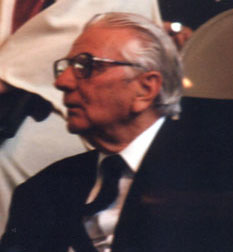
Dr. J. Davis Goldsmith attending our 40th Anniversary service and shortly before his death.
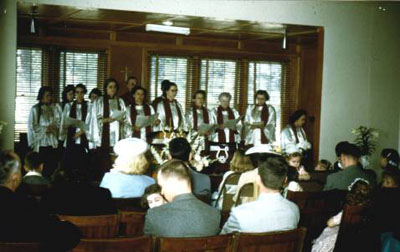
Easter 1956 in the white house sanctuary.
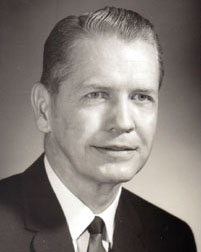
Rev. Herbert Baucom
The white house was used as both a youth ministry house and by other community agencies to benefit persons in crisis. Under Rev. Baucom's leadership the church called Rev. Ralph Grow as the Minister of Education and Youth. First Baptist Church was now a church with two ministers.
After Rev. Grow resigned, Rev. John Rogers was called as Associate Pastor to work with Rev. Baucom. Rev. Baucom, after nine years of service, moved back to his native North Carolina.
On July 1, 1975, Dr. Bob May was called as fourth pastor. As ministry opportunities increased during the 70s, it was clear that the church needed to expand.
From 1976 to 1980 the city of Gaithersburg grew at an unprecedented pace. By faith the church launched into erecting an education addition as a west wing to the sanctuary. Rev. John Rogers relocated. Under Dr. May's leadership, Rev. Katie Grogan was called as Minister of Education.

A building committee, again chaired by Mr. Bill Norman, completed the west wing education project in 1979. (This building contains our current fellowship hall and kitchen, which has greatly assisted the church in growth). Dr. May resigned to become a missionary to Brazil.
Rev. Charles Updike was called as the fifth pastor in July 1980. Challenging the church to grow in grace and outreach, Rev. Updike led the church to expand again. In 1981 Rev. Steven Kimmel was called as Associate Pastor to assist in the expansion of the church.
In 1982, the white house was deemed unusable and razed to create more parking space.
In 1984 the church erected the east education wing. Rev. Updike presided in the groundbreaking service. Mrs. Jane Clark's focused leadership as chairperson of the building committee guided the church to completion of this project.
The church called Rev. Andy Madsen as Minister of Youth and Music in 1985. His successor Rev. Lance Howerton directed the church towards a larger vision in Music and Youth Ministries. Rev. Howerton served with us from 1987-1990 and laid the base for our current youth ministry. During that period, the church increased again in size and spirit. Rev. Chip Cagle joined our staff as Minister of Education in 1988. In 1991, Rev. Mark Holmes was called as Pastor of Education and Youth. Mark's ministry among us helped enlarge both our youth and education ministries. Rev. Holmes served until 1996.
In November 1991, the church called Rev. Tim Mann as its first Pastor of Music and Worship. In 1995, the church took another step of faith to develop adults in discipleship. Ann Carol Mann was called as Minister of Adult Discipleship on a part-time basis.
In March 1995, the church adopted a design for our current sanctuary. Chairman of the Sanctuary Building Committee, Bob Buschman, gave outstanding visionary leadership to the task.
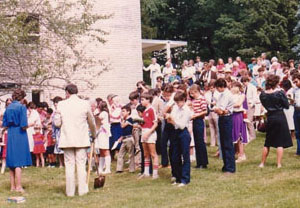
Chair of Building Committee Jane Clark and Pastor Updike leading ground breaking in 1984.
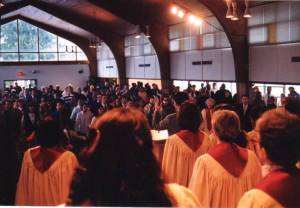
1995 worship service
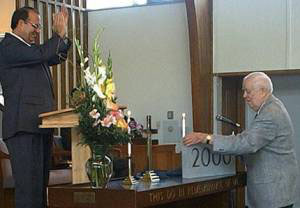
Bill Norman presents the cornerstone to be installed at completion of the project.
When Rev. Mark Holmes departed to pursue hospital chaplaincy in 1997, the church called Rev. Bryan Brock to be Pastor of Education. Rev. Matt Gaines joined the staff as Pastor of Music and Worship in 1998.
The current sanctuary groundbreaking occurred on Thanksgiving Sunday, 1999. First Baptist was well outside the limits of our sanctuary in 1999. Note the picture of persons outside the room in the second service.
The church had the privilege of ordaining and calling Rev. Shaun King as the first full time Pastor of Youth in 1999. Shaun served with the church until accepting the call of the First Baptist Church of Etowah, TN to serve as Senior Pastor in May, 2002.
The church broke ground on our current sanctuary Thanksgiving weekend, 1999. The congregation went through a year of construction with a great spirit, ever lifting the cross of Christ to our city.
With great anticipation and excitement, the church transitioned from the old to the new on a Christmas Eve Sunday morning. The service began in the old sanctuary and moved to the new with pastors carrying the advent candles from one to the other.
The first service of worship in the new sanctuary was Christmas Eve, 2000. The sanctuary has high vaulted wood ceilings and is shaped in an octagon. It seats 980 worshipers.
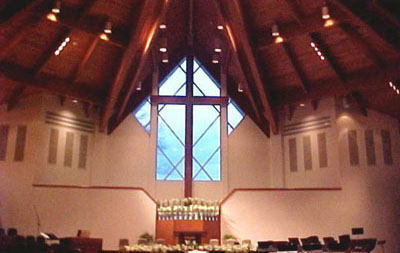
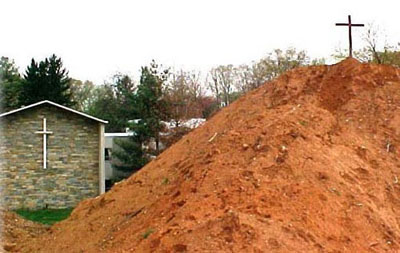
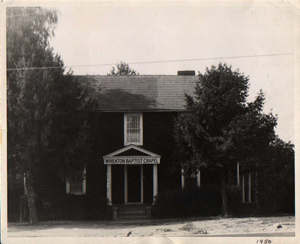
In 1949, as the Washington, D.C. suburb of Wheaton, Maryland found itself in a post-WWII growth spurt, a number of Baptist Christians felt the calling of God to explore the establishment of a Baptist church in their town; and so “Wheaton Baptist Chapel” was born. Many members of the original group were part of National Memorial Baptist Church in D.C., and that church encouraged and supported the new congregation in Wheaton. In large part because of that connection, the Chapel also chose to affiliate with the DC Baptist Convention, and the national bodies with whom it cooperated. Wheaton Baptist Chapel became “First Baptist Church of Wheaton” in 1951 and remained a central part of the Wheaton community until its relocation at the end of 2011.
But a church family needs a place to meet; so a couple of farmhouses at the intersection of Georgia Avenue and Veirs Mill Road (commonly known as the “Old Brown Building” and the “Little White House”) were graciously made available and eventually were converted into the first sanctuary, parsonage, and Sunday School classrooms. In 1954-55, the first new building was built; in 1960-61 the second phase; and in 1967, the final Sanctuary unit was constructed.
The pastoral history of the church is simple and straightforward. Though there was initial temporary pastoral help provided, and a series of brief interims decades later, the church had but two pastors throughout its entire history. Rev. B. Ross Morrison served faithfully from 1950 to 1990, and Dr. D. Edward Williams followed by serving from 1991 through 2015. As the church grew and changed over time, the pastors and the church family were blessed by an innumerable number of wonderful ministerial and administrative staff members as well.
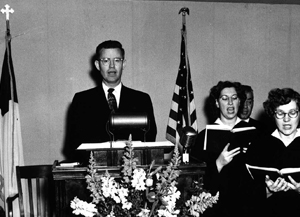
Pastor Morrison preaching in 1950.
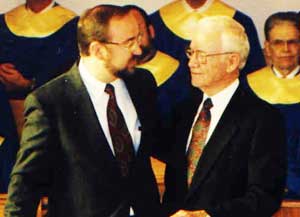
Both pastors together.
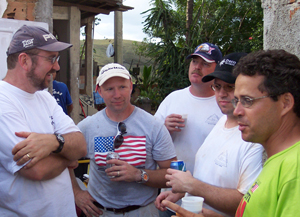
Pastor Williams with 2005 mission team.
Over the years, multiplied thousands worshipped as part of the congregation. Many learned of Christ and were baptized, joined the church family and served, and ministered. So many others exchanged wedding vows, watched their children grow in the knowledge of God, offered themselves in service as pastors and missionaries in response to the call of God, and rejoiced in the innumerable acts of God’s grace that they were privileged to witness there. In time, FBCW became a truly multicultural congregation, with members from over 25 nationalities in a congregation numbering just 250 people.
In 2003, FBC Wheaton established a team to explore new opportunities and to help enunciate a new vision. Unclear to anyone at that time was how that process would eventually lead FBCW to vote unanimously in late 2005 to sell its property in Wheaton and relocate — to Olney, MD, as it turned out. A beautiful 15-acre property was purchased with the intent of building a new facility; while initial steps went well, eventually a legal block created a time of reassessment, creating the need for interim locations.
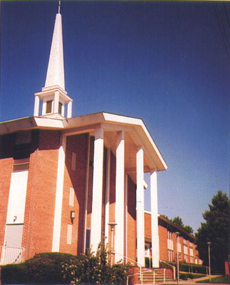
First Baptist Church of Wheaton
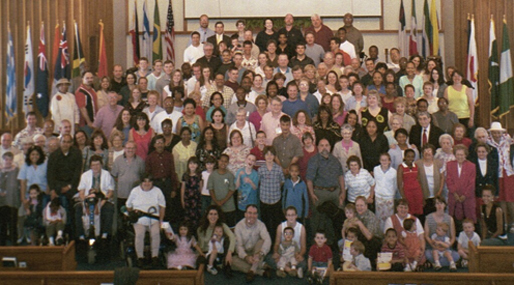
The 2004 FBCW Church Family
In anticipation of the relocation, FBC Wheaton changed its name to Streams of Hope Church in 2008, along with changes in governance and ministry approach. An economic recession slowed the relocation process until the end of 2011. On January 1, 2012, Streams of Hope held its first service in Olney at Washington Christian Academy, old friends from the Wheaton area who welcomed the church from 2012 through 2014. The school property changed ownership, and in January of 2015, Streams of Hope relocated to the chapel of First Baptist Church of Gaithersburg. Though the initial relationship was one of landlord/renter, both churches agreed to research, discuss, and pray about a potential merger.
The two congregations, First Baptist Church of Gaithersburg and Streams of Hope, created a Merger Exploration Team to work through the possibilities, and the congregations began to worship together once a month during 2015. An incredible amount of hard work was done, various presentations were made to the congregations, and in December 2015, each congregation voted separately to affirm the merger with approvals over 90%; and on January 1, 2016 the “Unified Church” was born. By February the church had selected the name Pathways Baptist Church, and within a few months all required legal documents had been approved to make the merger complete.
Grateful for the legacy and spirit of First Baptist Church of Wheaton and Streams of Hope Church, with joy we continue the journey as part of Pathways Baptist Church!